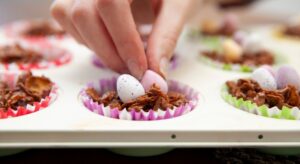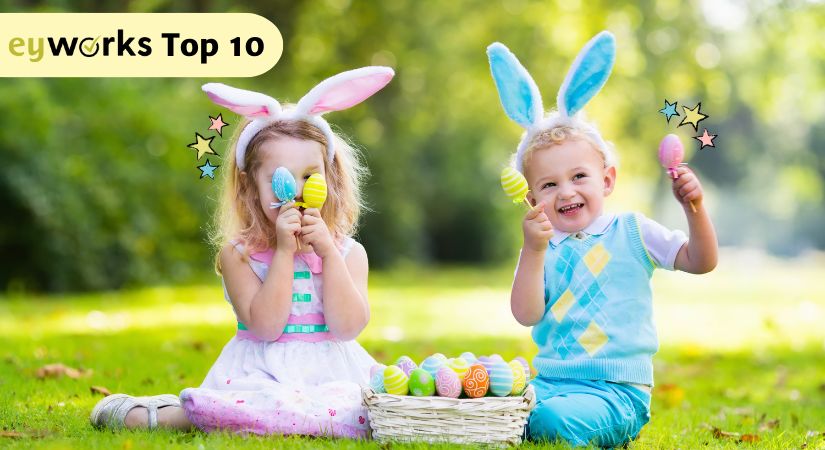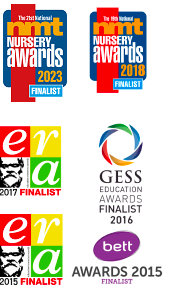As spring flowers bloom and Easter festivities approach, it’s the perfect time to infuse your nursery with a burst of energy and creativity. We’ve curated a list of our top 10 Easter activities for toddlers in Early Years settings. Plus, following on from an inspiring eymeets with Mandy Richardson, we’ll sprinkle in some tips on how to make these activities environmentally conscious too!
Contents:
Spring Nature Walk and Puddle Jumping
Easter Egg Hunt
Setup:
Set up an interactive Easter Egg Hunt for toddlers by hiding eggs throughout a designated space, indoors or outdoors. Consider incorporating simple clues or visual cues to help toddlers locate the eggs. Use various colours and sizes to add an extra element of excitement. Encourage toddlers to explore and discover the hidden treasures independently or with a bit of guidance.
Learning Benefits:
Gross Motor Skills Development: Engaging toddlers in an interactive Easter Egg Hunt promotes the development of gross motor skills as they move, walk, or run around to search for hidden eggs. This physical activity contributes to their overall coordination and motor skill refinement.
Cognitive Stimulation through Problem-Solving: The inclusion of simple clues or visual cues during the egg hunt encourages toddlers to engage in problem-solving. Figuring out where the eggs are hidden stimulates cognitive processes and enhances their ability to make connections.
Sensory Exploration: The use of a variety of colours and sizes for the hidden eggs adds a sensory dimension to the activity. Toddlers can explore and differentiate between the visual stimuli, enhancing their sensory awareness.
Independence and Decision-Making: Encouraging toddlers to explore and discover the hidden treasures independently or with guidance promotes a sense of independence. Making choices about where to search for eggs and deciding on the best approach fosters early decision-making skills.
Social Interaction and Language Development: If done with others, the interactive Easter Egg Hunt provides an opportunity for social interaction. Collaborating with peers or caregivers to find eggs promotes positive social experiences, and discussions about the hunt contribute to language development.
Eco-Friendly Tip: Use reusable and eco-friendly containers for the egg hunt, such as fabric bags or baskets.

Planting Seeds
Setup:
Set up a seed planting station with a variety of seeds, small pots, and child-friendly gardening tools. Demonstrate how to plant seeds, and let toddlers take charge of the process with minimal assistance. As the seeds grow into plants, track the growth with the children and discuss more about the plant lifecycle.
Learning Benefits:
Fine Motor Skills Development: Engaging toddlers in a seed planting activity with child-friendly gardening tools promotes the development of fine motor skills as they manipulate seeds, pots, and tools. This hands-on experience encourages precise movements and finger dexterity.
Cognitive Stimulation through Hands-On Learning: Participating in the seed planting process stimulates cognitive development as toddlers learn about the plant lifecycle through hands-on experience. Observing the seeds grow into plants fosters an understanding of cause and effect and introduces basic concepts of biology.
Sensory Exploration and Nature Connection: Handling seeds and soil offers sensory exploration opportunities, connecting toddlers with nature. Feeling the texture of seeds and soil enhances sensory awareness and fosters a deeper appreciation for the natural world.
Promotion of Independence and Responsibility: Allowing toddlers to take charge of the planting process with minimal assistance promotes independence and responsibility. Taking ownership of caring for the planted seeds instils a sense of pride and accomplishment in toddlers as they witness the growth of their plants.
Environmental Awareness and Eco-Literacy: Engaging in seed planting introduces toddlers to environmental concepts and fosters eco-literacy. Discussing the plant life cycle and the importance of caring for plants promotes environmental awareness and encourages a sense of responsibility towards nature.
Eco-Friendly Tip: Choose organic seeds to promote biodiversity and avoid the use of chemical pesticides in future plant growth.
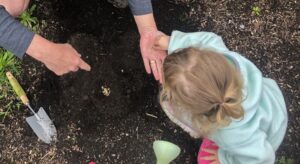
Spring Storytime
Setup:
Sit in a cosy space with babies and read Easter-themed books with toddlers. Choose interactive books with detailed illustrations and simple narratives. Encourage toddlers to participate by asking questions about the story, and characters, or pointing out specific details.
Some books we recommend are:
The Tale of Peter Rabbit by Beatrix Potter
Llama Llama Easter Egg by Anna Dewdney
We’re Going on an Egg Hunt by Martha Mumford
The Dinosaur that Pooped Easter by Dougie Poynter and Tom Fletcher
Learning Benefits:
Cognitive Stimulation through Detailed Illustrations: Selecting interactive books with detailed illustrations provides cognitive stimulation for toddlers. The richness of visual details in the illustrations enhances their ability to observe, focus, and make connections between images and the narrative.
Language Development and Narrative Comprehension: Encouraging toddlers to participate in the story by asking questions or pointing out details fosters language development and narrative comprehension. This interactive approach promotes the understanding of storytelling elements and the ability to express thoughts and observations.
Fine Motor Skills Enhancement through Pointing: The act of pointing out specific details in the illustrations contributes to the enhancement of fine motor skills. Toddlers refine their ability to coordinate hand movements and develop precision as they engage with the images in the books.
Social Interaction and Bonding: Reading interactive books with toddlers creates a shared and interactive experience. Asking questions about the story and characters promotes social interaction between caregivers and toddlers, strengthening the emotional bond during reading sessions.
Introduction to Literary Appreciation: Exposing toddlers to interactive books by well-known authors like Beatrix Potter, Anna Dewdney, Martha Mumford, Dougie Poynter, and Tom Fletcher introduces them to literary appreciation. Early exposure to quality literature sets the foundation for a lifelong love of reading.
Eco-Friendly Tip: Borrow books from local libraries, purchase them second hand in charity shops, or share books within the community to reduce the need for new printed materials.
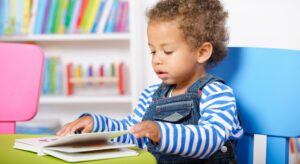
Spring Nature Walk and Puddle Jumping
Setup:
Lead toddlers on an interactive nature walk. Encourage them to explore various textures, smells, and colours in the environment. Use simple language to identify different elements of nature, fostering their curiosity about the world around them. On a rainy day, provide rain boots and encourage toddlers to jump in puddles outdoors.
Learning Benefits:
Sensory Exploration and Awareness: Leading toddlers on an interactive nature walk encourages sensory exploration as they touch various textures, smell different scents, and observe vibrant colours in the environment. This enhances their sensory awareness and connection with the natural world.
Language Development through Nature Identification: Encouraging toddlers to explore nature and using simple language to identify different elements, such as plants, flowers, or animals, fosters language development. This activity promotes vocabulary expansion and the ability to express observations.
Motor Skills Development through Exploration: Actively exploring the outdoor environment during the nature walk contributes to the development of gross and fine motor skills. Toddlers engage in activities such as walking, bending, touching, and picking up objects, refining their coordination and dexterity.
Curiosity and Cognitive Stimulation: Fostering toddlers’ curiosity about the world around them through an interactive nature walk stimulates cognitive development. Observing and questioning different aspects of nature promote early cognitive processes and critical thinking skills.
Emotional Well-being and Joyful Outdoor Experience: Providing opportunities for toddlers to jump in puddles during a rainy day adds an element of joy to the outdoor experience. Engaging in such playful activities contributes to emotional well-being and creates positive associations with outdoor exploration.
Eco-Friendly Tip: Encourage children to point out litter for adults to collect during the nature walk, fostering a sense of environmental responsibility and leaving the area cleaner than before.
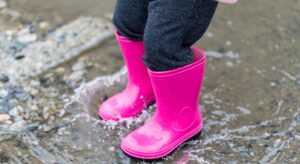
Easter Card Making
Setup:
Set up a card-making station with various craft materials such as coloured paper, markers, glue, and embellishments. Encourage toddlers to create Easter cards with their own designs.
Learning Benefits:
Fine Motor Skills Development: Setting up a card-making station with various craft materials encourages toddlers to engage in fine motor activities. Cutting, gluing, and handling small embellishments contribute to the development of fine motor skills, enhancing coordination and finger dexterity.
Cognitive Stimulation and Creativity: The process of creating Easter cards stimulates cognitive development and creativity. Toddlers make decisions about colours, shapes, and designs, fostering their imaginative thinking and cognitive abilities.
Expression of Individuality: Encouraging toddlers to create Easter cards with their own designs promotes the expression of individuality. Each card becomes a unique representation of the toddler’s creativity and allows them to convey their personality through art.
Social Interaction and Communication Skills: If done in a group setting, the card-making activity provides opportunities for social interaction. Sharing materials, discussing designs, and expressing ideas with peers or caregivers contribute to the development of communication and social skills.
Emotional Well-being and Sense of Accomplishment: Engaging in a creative activity like making Easter cards contributes to emotional well-being. Toddlers experience a sense of accomplishment as they see their creations come to life, boosting their confidence and self-esteem.
Eco-Friendly Tip: Create cards from recycled or upcycled materials, adding a personal touch while minimising waste.

Bunny Ears Relay
Setup:
Set up a dynamic bunny ears relay with designated starting and finishing points. Toddlers can take turns wearing and passing bunny ears to the next participant.
Learning Benefits:
Gross Motor Skills Development: Setting up a dynamic bunny ears relay involves movement and coordination, promoting the development of gross motor skills. Toddlers engage in activities such as running, walking, and passing the bunny ears, enhancing their overall physical coordination.
Social Interaction and Cooperation: The relay format encourages social interaction and cooperation among toddlers. Taking turns wearing and passing bunny ears fosters teamwork and positive social engagement, contributing to the development of social skills.
Balance and Coordination Improvement: Participating in the relay requires toddlers to maintain balance and coordinate their movements. Activities like running while wearing bunny ears challenge their balance, contributing to the improvement of these essential skills.
Following Instructions and Turn-Taking: The relay structure involves following instructions and taking turns. Toddlers learn to listen to directions, wait for their turn, and follow the rules of the game, promoting the development of listening skills and turn-taking abilities.
Physical Activity and Energy Release: Engaging in a dynamic bunny ears relay provides an outlet for physical activity and energy release. Toddlers have the opportunity to move and be active in a playful setting, contributing to their overall well-being and supporting a healthy level of physical activity.
Eco-Friendly Tip: Craft bunny ears from recycled materials or repurposed fabric, adding an eco-friendly element to the relay.
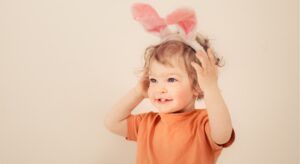
Spring Picnic
Setup:
Organise an outdoor spring picnic with toddler-friendly snacks. This could be in your nursery garden or at the local park. Spread out a picnic blanket and encourage toddlers to sit, eat, and enjoy the surroundings. Bring along some toys or soft cushions for added comfort.
Learning Benefits:
Social Interaction and Bonding: Organising an outdoor spring picnic provides an opportunity for social interaction and bonding among toddlers. Sitting together, sharing snacks, and engaging in play promote positive social experiences, fostering connections and friendships.
Fine Motor Skills Enhancement: Encouraging toddlers to handle toddler-friendly snacks during the picnic supports the development of fine motor skills. Grasping and manipulating small snacks contribute to the refinement of hand-eye coordination and finger dexterity.
Sensory Exploration in Nature: Conducting the picnic outdoors allows toddlers to engage in sensory exploration in a natural setting. Feeling the texture of the grass, observing the colours of flowers, and experiencing the breeze contribute to sensory awareness and a connection with the natural environment.
Language Development through Communication: The outdoor picnic setting creates opportunities for communication. Toddlers can express preferences, share experiences, and engage in conversations with peers or caregivers. This contributes to language development and the ability to express thoughts and feelings.
Promotion of Relaxation and Well-being: Enjoying a picnic outdoors, surrounded by nature, promotes relaxation and a sense of well-being. The open environment, combined with comfortable seating arrangements such as blankets and cushions, creates a peaceful and enjoyable setting for toddlers to unwind.
Eco-Friendly Tip: Choose reusable or biodegradable picnicware and pack sustainable, locally sourced snacks to reduce environmental impact.
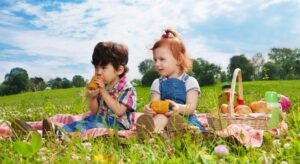
Egg Bowling
Setup:
Set up an egg bowling game using plastic eggs as pins and a small ball for rolling. Designate a bowling lane and encourage toddlers to take turns rolling the ball to knock down the egg pins.
Learning Benefits:
Gross Motor Skills Development: Setting up an egg bowling game involves rolling a ball to knock down plastic egg pins, promoting the development of gross motor skills. Toddlers engage in movements such as rolling and throwing, enhancing their overall coordination and motor skill refinement.
Hand-Eye Coordination Improvement: Participating in the egg bowling game requires toddlers to coordinate their hand movements with their visual perception. Rolling the ball with precision to knock down the egg pins enhances hand-eye coordination, a crucial skill for various activities.
Social Interaction and Turn-Taking: The game format encourages social interaction among toddlers. Taking turns rolling the ball and cheering for each other fosters a sense of camaraderie and promotes turn-taking skills, contributing to social development.
Cognitive Stimulation through Aim and Accuracy: Engaging in the egg bowling game stimulates cognitive processes related to aim and accuracy. Toddlers learn to judge distances, adjust their aim, and observe the outcomes of their actions, fostering cognitive development in a playful context.
Enjoyable Physical Activity: The egg bowling game provides an enjoyable way for toddlers to engage in physical activity. The combination of rolling a ball and knocking down egg pins adds an element of fun to the experience, promoting an active and positive attitude towards physical play.
Eco-Friendly Tip: Choose biodegradable or recycled eggs for the bowling game to reduce the environmental impact of plastic use.

Bunny Hop Freeze Dance
Setup:
Create a bunny hop dance space with lively music. Encourage toddlers to imitate bunny hops, twirls, and simple dance moves. Periodically pause the music, prompting them to freeze in a bunny hop position before starting again. Incorporate bunny-themed props or costumes for added fun.
Learning Benefits:
Gross Motor Skills Development: Creating a bunny hop dance space with lively music encourages toddlers to engage in various gross motor movements, such as bunny hops, twirls, and dance moves. This promotes the development of coordination, balance, and overall gross motor skills.
Rhythm and Movement Coordination: Dancing to lively music allows toddlers to experience rhythm and practice coordinating their movements with the beat. This activity enhances their sense of timing and movement coordination, contributing to their overall physical development.
Creative Expression and Imagination: Encouraging toddlers to imitate bunny hops and incorporate simple dance moves fosters creative expression and imagination. The playful dance space provides a platform for toddlers to express themselves through movement, promoting creativity.
Listening Skills and Following Instructions: Pausing the music periodically and prompting toddlers to freeze in a bunny hop position enhances their listening skills and ability to follow instructions. This aspect of the activity supports cognitive development and the development of early listening and response skills.
Social Interaction and Group Participation: Dancing in a group setting promotes social interaction among toddlers. They can observe and imitate each other, fostering a sense of camaraderie. Incorporating bunny-themed props or costumes adds an element of shared fun and enhances the sense of group participation.
Eco-Friendly Tip: Source bunny themed props and costumes from charity shops or ask parents to donate outfits their children have grown out of.
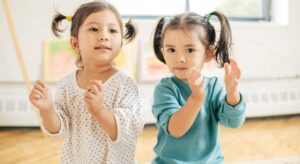
Chocolate Bird’s Nests
Setup:
Set up a designated chocolate bird’s nest-making station for toddlers. Use real chocolate under close supervision. Provide pre-measured cornflakes in a bowl and encourage toddlers to pour the melted chocolate over them. Use silicone cupcake moulds for portioning, and offer a variety of toppings like mini-eggs for decoration.
Learning Benefits:
Fine Motor Skills Enhancement: Setting up a designated chocolate bird’s nest-making station involves fine motor activities, such as pouring melted chocolate and decorating with toppings. Toddlers engage in precise movements, enhancing their fine motor skills and coordination.
Sensory Exploration through Texture and Taste: Handling melted chocolate and pouring it over pre-measured cornflakes provides toddlers with a sensory exploration experience. This activity introduces them to different textures and tastes, contributing to sensory awareness and the development of their palate.
Cognitive Stimulation and Decision-Making: Encouraging toddlers to pour melted chocolate and choose toppings stimulates cognitive processes. Toddlers make decisions about the quantity of chocolate and the selection of toppings, fostering early decision-making skills and cognitive development.
Promotion of Independence and Responsibility: Allowing toddlers to participate in making chocolate bird’s nests promotes a sense of independence and responsibility. Taking charge of pouring and decorating their nests instils a feeling of accomplishment and encourages autonomy in the culinary process.
Culinary Exploration in a Safe Environment: Engaging in a chocolate bird’s nest-making activity offers toddlers a safe and controlled environment for culinary exploration. The use of real chocolate under close supervision ensures a secure setting for them to learn about food preparation and cooking processes.
Eco-Friendly Tip: Incorporate locally sourced and organic ingredients for the chocolate bird’s nests, reducing the environmental impact of food production and supporting sustainable agriculture practices.
